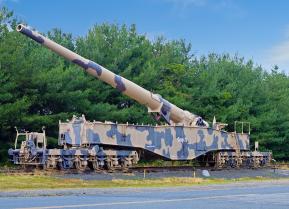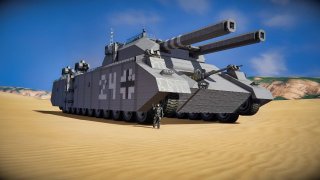Landkreuzer P. 1000 Ratte: Hitler Had a Plan to Build the Largest Tank Ever
By some accounts, the Landkreuzer – which was the brainchild of Krupp director Edward Grotte – was among the designs that were simply too ambitious to ever have been constructed. In many ways, this massive 1,000-ton tank was a throwback to the original "landship program" considered by the British military during the First World War.
The Landkreuzer P. 1000 Ratte Was the Most Ambitious Tank Ever Devised - During the Second World War, the German military thinkers certainly thought big when it came to tanks and produced some of the largest tanks ever to roll across a battlefield. That included the Tiger II, arguably the most powerful tank of the war, while there were also limited/wasted efforts to develop the Panzerkampfwagen VIII Maus, the largest tank ever built.
Just two prototypes of that super tank were completed, yet it likely would have done little to turn the tide for the Nazis.
However, even that massive 188-tonne monstrosity could be seen as almost "mouse-like" when compared to the Landkreuzer P. 1000 Ratte.
Landkreuzer P. 1000 Ratte - A True Landship
By some accounts, the Landkreuzer – which was the brainchild of Krupp director Edward Grotte – was among the designs that were simply too ambitious to ever have been constructed. In many ways, this massive 1,000-ton tank was a throwback to the original "landship program" considered by the British military during the First World War. However, the British soon saw that true landships weren't the answer – and that lead to the more modest tanks, which were still massive for the era.
The Germans apparently didn't get the memo, but then again, its own tank program resulted in the A7V, a vehicle that required a crew of 18, but which was sometimes increased to 25.
During the interwar era, the Germans developed fast-moving light tanks, but apparently, the idea of an enormous landship was considered again.
Albert Speer, who served as Reich Minister of Armaments and War Production, helped design the massive behemoth. Speer, who had more experience as an architect than an engineer, certainly thought "big" and had worked directly with Adolf Hitler with the plans to rebuild Berlin as Germania. Among the most ambitious of the buildings was the Volkshalle, a new domed structure similar in design to the Roman Pantheon, and which was meant to dwarf every other building in the city.
Speer seemed to think equally big with the Landkreuzer P. 1000 Ratte, which was to have a length of 35 meters (115 ft), a height of 11 meters (36 ft), and a width of 14 meters (46 ft). It would have required six 1.2 meter tracks for movement, while at least eight Daimler-Benz 20-cylinder diesel marine engines would have been needed to power the vehicle.
It would have certainly been too large to transport by train, so it remains unclear how it could have ever gotten to the front lines. Even its speed, which was to be 40 km/h (24 mph), was thought to be overly optimistic.
Landkreuzer P. 1000 Ratte: A Mobile Fortress?
Had it been even possible to build it – and Germany certainly lacked the means after 1943 – it was estimated that it would have cost around $1.4 million in today's money. But it would have been quite the weapon, and arguably would have been more like a mobile fortress than a tank.
The Landkreuzer P. 1000 Ratte would have required a crew of at least 40, while it could have included a bay large enough to carry a reconnaissance motorcycle squadron. It would have had 300 tons of armor plating, up to 10-inches thick in some places.
It was to be armed with at least two 280mm guns, mounted in turrets similar to those employed on the Scharnhorst-class battleships, while additional armament would have included at least one 128mm gun, eight 20mm Flak guns for anti-aircraft, and two 15mm machine guns.
In the end, however, it was a fantasy weapon. Perhaps something good to consider in video games, but in reality, it would have been a waste of time, materials, and effort. The slow-moving vehicle could have been easily targeted by enemy aircraft, it couldn't have effortlessly crossed any rivers, and it would have required more fuel than Germany could have provided to keep it rolling.
Sometimes bigger isn't better.
About the Author
Peter Suciu is a Michigan-based writer who has contributed to more than four dozen magazines, newspapers and websites. He regularly writes about military hardware, firearms history, cybersecurity and international affairs. Peter is also a Contributing Writer for Forbes.
All images are Creative Commons.


